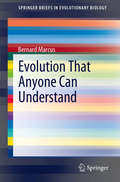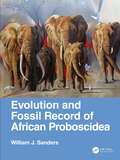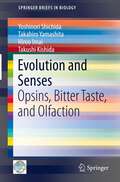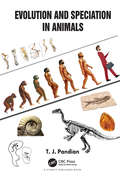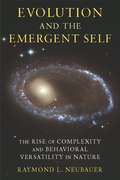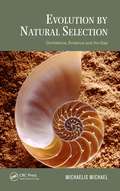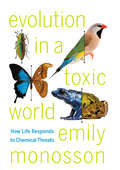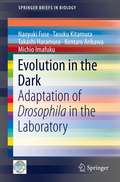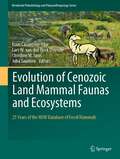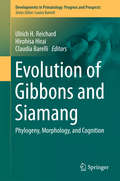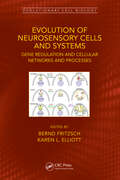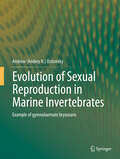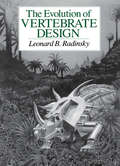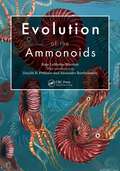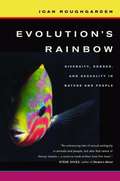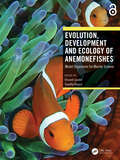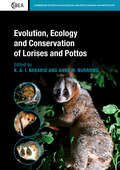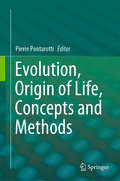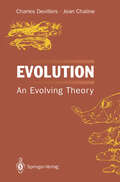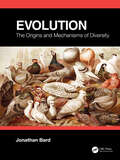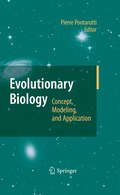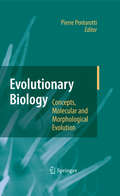- Table View
- List View
Evolution That Anyone Can Understand
by Bernard MarcusThe function of scientific research is promoting the understanding of the world around us. In theory, anyway, the more we learn, the more potential we have of making our lives better. Thus, we have seen research in electronics provide us with computers, research in chemistry provide us with all manner of synthetics, and research in agriculture provide us with more food. Periodically, scientific research uncovers something that makes some of us uncomfortable. The discovery of the link between smoking and lung cancer and heart disease was not received well by the tobacco industry, and the link between global climate change and fossil fuel use has not been well received by the petroleum industry, to cite just two examples. Usually the response of those whose world has been disrupted by science is denial, often followed by attack on or ridicule of the science that has challenged them. In the long term, however, science usually turns out to be correct.
Evolution and Fossil Record of African Proboscidea
by William J. SandersThis book details the long, diverse, and complex phylogenetic history of elephants and their fossil relatives (the Proboscidea), whose origin is deeply embedded some 60 million years ago in Africa. Most of the major evolutionary events of proboscideans occurred in Africa, and these are examined in their geological, paleoecological, geographic, and faunal contexts. Updated information about feeding adaptations, taxonomy and systematics, genetics, and site occurrences is included and summarized in tables, figures, and charts. This is the first comprehensive review of African proboscideans and illustrates the need to more actively protect elephants and ensure their survival in modern ecosystems. Key Features: Provides a comprehensive systematic review of the African proboscidean fossil record Includes a summary of taxonomy, geochronology, biogeography and morphology Documents major faunal events including those associated with hominin origins Synthesizes new data from genomic, isotopic, and microware analyses Emphasizes the role of elephants in ecosystems and the importance of conservation
Evolution and Senses
by Yoshinori Shichida Takahiro Yamashita Hiroo Imai Takushi KishidaThis book focuses on sensing and the evolution of animals. Using the five senses (visual, auditory, and olfactory perception, and taste and touch), animals can receive environmental stimuli and respond to them. Changes in these sensitivities might cause changes in aspects of animals' lives such as habitat, activity timing, and diet--and vice versa. Recent advances in genome and molecular analysis enable us to investigate certain changes in the receptors or mechanisms involved in sensing and provide clues for understanding the evolution of animals related to those changes. The first chapter deals with the molecular evolution of opsins. In addition to the well-known function of opsins as visual receptors, opsins can be related to non-visual photoreception such as photoentrainment of circadian rhythm, photoperiodism, and background adaptation. Molecular phylogenic studies reveal that all opsin genes have evolved from one ancient opsin gene. The evaluation of the functions of each extant opsin protein based on the molecular features enables us to predict the molecular evolution and diversification of opsins during the evolution of animals. These studies shed light on which amino-acid substitutions cause the functional diversification of opsins and how they have influenced the evolution of animals. The second chapter has to do with bitter taste perception, a key detection mechanism against the ingestion of bioactive substances. Genetic and behavioral evidence reveal the existence of "non-taster" Japanese macaques for specific bitter compounds, which originated in a restricted region of Japan. This finding might provide a clue for elucidating the ecological, evolutionary, and neurobiological aspects of bitter taste perception of primates. The third chapter presents an extreme example of the evolution of olfaction, namely, that fully aquatic amniotes have generally reduced their olfactory capacity considerably compared to their terrestrial relatives. Interestingly, the remaining olfactory abilities are quite different among three fully aquatic amniotes investigated: toothed whales have no nervous system structures that mediate olfaction, but baleen whales can smell in air, and it has been suggested that sea snakes smell underwater.
Evolution and Speciation in Animals
by T. J. PandianThis book represents the first attempt to quantify environmental factors and life history traits that accelerate or decelerate species diversity in animals. About 15%, 8% and 77% of species are distributed in marine (70% of earth’s surface), freshwater (terra firma fosters more diversity. The harsh hadal, desert and elevated montane habitats restrict diversity to 0.5-4.2%. Costing more time and energy, osmotrophic and suspension modes of food acquisition limit diversity to Selfing hermaphrodites (0.9%), parthenogens ( Incidence of heterogamety is four-times more in males than in females. Hence, evolution is more a male-driven process. Egg size is determined by environmental factors, but lecithality is genetically fixed. In poikilotherms, sex is also determined by gene(s), but differentiation by environmental factors. The extra-ovarian vitellogenesis (> 96%), spermatozoan (81%) rather than spermatophore mechanism of sperm transfer, promiscuity and polygamy over monogamy, iteroparity (99.6%) over semelparity and internal fertilization (84%) are preferred, as they accelerate diversity. Body size and egg size determine fecundity. Indirect life cycle (82%) and incorporation of feeding larval stages accelerate diversity. Brooding and viviparity (6.4%) decelerate it. Parasitism extends life span and liberates fecundity from eutelism. Evolution is an ongoing process, and speciation and extinction are its unavoidable by-products. The in-built conservation mechanism of reviving life after a sleeping duration has been reduced from a few million years in microbial spores to a few thousand years in plant seeds and a few hundred years in dormant eggs in animals. Hence, animal conservation requires priority. The existence of temperature-resistant/insensitive individuals, strains and species shall flourish during the ongoing global warming and earth shall continue with such burgeoning species, hopefully inclusive of man.
Evolution and the Emergent Self: The Rise of Complexity and Behavioral Versatility in Nature
by Raymond L. NeubauerRaymond L. Neubauer presents a view of nature that describes rising complexity in life in terms of increasing information content, first in genes and then in brains. The evolution of the nervous system expanded the capacity to store information with relatively open-ended programs, making learning possible. Portraying four species with high brain-to-body ratios&mdashchimpanzees, elephants, ravens, and dolphins&mdashNeubauer shows how each shares with humans the capability for complex communication, social relationships, flexible behavior, tool use, and powers of abstraction. He describes this constellation of qualities as an emergent self, arguing that humanity is not the only self-aware species and that human characteristics are embedded in the evolutionary process and are emerging in a variety of lineages on our planet. Neubauer ultimately shows that human culture is not a unique offshoot of a language-specialized primate, but an extension of a fundamental strategy that organisms have used since the beginning of life on earth to gather information and buffer themselves from environmental fluctuations. Neubauer also views these processes in a cosmic setting, detailing open thermodynamic systems that become more complex as the energy flowing through them increases. Similar processes of increasing complexity can be found in "self-organizing" structures in both living and non-living forms. Recent evidence from astronomy indicates that planet formation may be nearly as frequent as star formation. In February 2011, NASA announced that the Kepler space telescope had located fifty-four planets in the habitable zones around their stars. Life makes use of the elements most commonly seeded into space by burning and exploding stars, and the evolution of life and intelligence that occurred on our planet may be common across the universe.
Evolution by Natural Selection: Confidence, Evidence and the Gap (Species and Systematics)
by Michaelis MichaelA persistent argument among evolutionary biologists and philosophers revolves around the nature of natural selection. Evolution by Natural Selection: Confidence, Evidence and the Gap explores this argument by using a theory of persistence as an intentional foil to examine ways in which similar theories can be misunderstood. It discusses Charles Dar
Evolution in a Toxic World
by Emily MonossonWith BPA in baby bottles, mercury in fish, and lead in computer monitors, the world has become a toxic place. But as Emily Monosson demonstrates in her groundbreaking new book, it has always been toxic. When oxygen first developed in Earth's atmosphere, it threatened the very existence of life: now we literally can't live without it. According to Monosson, examining how life adapted to such early threats can teach us a great deal about today's (and tomorrow's) most dangerous contaminants. While the study of evolution has advanced many other fields of science, from biology to medicine, toxicology has yet to embrace this critical approach. In Evolution in a Toxic World, Monosson seeks to change that.
Evolution in the Dark
by Naoyuki Fuse Tasuku Kitamura Takashi Haramura Kentaro Arikawa Michio ImafukuHow organisms come to possess adaptive traits is a fundamental question for evolutionary biology. Although it is almost impossible to demonstrate evolution in the laboratory, this issue can be approached by using an unusual organism, "Dark-fly": Drosophila melanogaster kept in complete darkness for 57 years through 1,400 generations, which corresponds to 28,000 years in terms of human generations. Has Dark-fly adapted to an environment of total darkness? If so, what is the molecular nature of the adaptation? In Evolution in the Dark, the remarkable findings from the Dark-fly project performed at Kyoto University are presented. It was found that Dark-fly did not have poor eyesight, but rather exhibited higher phototaxis ability and displayed lengthened bristles on the head that function as tactile receptors. Circadian rhythms were weakened but still retained in Dark-fly. With recent progress in genome science enabling researchers to perform whole genome sequencing for Dark-fly, a large number of mutations were identified including genes encoding a light receptor, olfactory receptors, and enzymes involved in neural development. The Dark-fly project is a simple but very long-term experiment. Combined with advanced techniques in genetics and genomics, it is a valuable tool for understanding the molecular nature of adaptive evolution.
Evolution of Cenozoic Land Mammal Faunas and Ecosystems: 25 Years of the NOW Database of Fossil Mammals (Vertebrate Paleobiology and Paleoanthropology)
by Christine M. Janis Isaac Casanovas-Vilar Lars W. van den Hoek Ostende Juha SaarinenThis volume presents an array of different case studies which take as primary material data sourced from the NOW (‘New and Old Worlds’) database of fossil mammals. The NOW database was one of the very first large paleobiological databases, and since 1996 it has been expanded from including mainly Neogene European land mammals to cover the entire Cenozoic at a global scale. In the last two decades the number of works that are based in the use of huge databases to explore ecological and evolutionary questions has increased exponentially, and even though the importance of big data in paleobiological research has been outlined in selected chapters of general works, no volume has appeared before this one which solely focuses on the databases as a primary source in reconstructing the past. The purpose of this book is to provide an illustrative volume showing the importance of big data in paleobiological research, and presenting a broad array of unpublished examples and case studies. The book is mainly aimed to professional palaeobiologists working with Cenozoic land mammals, but the scope of the book is broad enough to fit the interest for evolutionary biologists, paleoclimatologists and paleoecologists.The volume is divided in four parts. The first part includes two chapters on the development of large paleobiological databases, providing a first-hand account on the logic and the functioning of these databases. This is a much-needed perspective which is ignored by most researchers and users of such databases and, even if centered in the NOW database, the lessons that can be learned from this part can be extended to other examples. After this introductory part, the body of the book follows and is divided into three parts: patterns in regional faunas; large scale patterns and processes; and ecological, biogeographical and evolutionary patterns of key taxa. Each chapter is written by well-known specialists in the field, with some participation of members of the NOW advisory board. The array of selected mammal taxa ranges from carnivores, equids, ruminants and rodents to the genus Homo. The topics studied also include the diversification and radiation of major clades, large-scale paleobiogeographical patterns, the evolution of ecomorphological patterns and paleobiological problems such as evolution of body size or species longevity. In most cases the results are discussed in relation to protracted environmental or paleogeographic changes.
Evolution of Gibbons and Siamang
by Hirohisa Hirai Ulrich H. Reichard Claudia BarelliThis volume provides insight into gibbon diet and community ecology, the mating system and reproduction, and conservation biology, all topics which represent areas of substantial progress in understanding socio-ecological flexibility and conservation needs of the hylobatid family. This work analyzes hylobatid evolution by synthesizing recent and ongoing studies of molecular phylogeny, morphology, and cognition in a framework of gibbon and siamang evolution. With its clearly different perspective, this book is written to be read, referenced, and added to the bookshelves of scientists, librarians, and the interested public.
Evolution of Neurosensory Cells and Systems: Gene regulation and cellular networks and processes (Evolutionary Cell Biology)
by Bernd FritzschThis book is an overview of primary sensory maps of vertebrates, characterized by continuous and discrete properties. The eight primary sensory maps of vertebrates have unique features and use distinct molecular cues, cell cycle exit, and activity combinations during development, regeneration, and plasticity. As an introduction and overview, the book provides a short overview for all eight sensory senses and presents through evolution and gene regulatory networks, the molecular cues needed for sensory processing. Independent contributions are included for olfactory, vision, trigeminal, taste, vestibular, auditory, lateral line, and electroreception.
Evolution of Sexual Reproduction in Marine Invertebrates
by Andrew Andrey N. OstrovskyThree major aspects that distinguish this book are that (1) it contains the most detailed analysis of the sexual reproduction (oogenesis, fertilization and embryonic incubation) in a particular phylum of the aquatic invertebrates (Bryozoa) ever made; this analysis is based on an exhaustive review of the literature on that topic published over the last 260 years, as well as extensive original histological, anatomical and morphological data obtained during studies of both extant and extinct species; (2) this broad analysis has made it possible to reconstruct the major patterns, stages and trends in the evolution of sexual reproduction in various bryozoan clades, showing numerous examples of parallelisms during transitions from broadcasting to embryonic incubation, from planktotrophic to non-feeding larvae and from lecithotrophy to placentation; corresponding shifts in oogenesis, fertilization and embryonic development are discussed in detail; and (3) the key evolutionary novelties acquired by Bryozoa are compared with similar innovations that have evolved in other groups of marine invertebrates, showing the general trends in the evolution of their sexual reproduction. Ecological background of these innovations is considered too. Altogether these aspects make the monograph an "Encyclopedia of bryozoan sexual reproduction," offering an integral picture of the evolution of this complex phenomenon.
Evolution of Vertebrate Design
by Leonard B. RadinskyThe Evolution of Vertebrate Design is a solid introduction to vertebrate evolution, paleontology, vertebrate biology, and functional, comparative anatomy. Its lucid style also makes it ideal for general readers intrigued by fossil history. Clearly drawn diagrams illustrate biomechanical explanations of the evolution of fins, jaws, joints, and body shapes among vertebrates. A glossary of terms is included. "A luminous text is matched by lucid drawings rationally placed. . . . A great teaching monograph, the book will charm lay readers of fossil history. For virtually every college & public collection."—Scitech Book News
Evolution of the Ammonoids
by Donald R. Prothero Kate LoMedico Marriott Alexander BartholomewAmmonites are an extinct and charismatic lineage that persisted for over 300 million years. They were used, with other fossils, to corroborate the principle of faunal succession and launch the field of biostratigraphy. Despite intense research, many important questions remain unanswered. Furthermore, outdated hypotheses persist. Many new findings include a better understanding of their appearance in life, their locomotion, and their role in long-gone ecosystems. And, of course, there are still controversies; e.g. why did shell complexity increase during evolutionary history. This richly illustrated book describes the full range of ammonoids and their fascinating evolutionary history. Key Features Documents the early history of paleontology and the role played by ammonoids Describes the basic anatomy of a diverse and long-persisting lineage Summarizes the classification and diversity of ammonoids Lavishly illustrated with beautiful reconstructions Highlights recent findings and outstanding controversies Related Titles Ponder, W. F. D. R. Lindberg and J. M. Ponder. Biology and Evolution of the Mollusca (Vol 1. ISBN 978-1-0321-7660-4, Vol 2. ISBN 9781032173542) Mente, E., eds. Reproductive Biology of Crustaceans: Case Studies of Decapod Crustaceans (ISBN 978-0-3674-5277-3) Koenemann, S. & R. Jenner, eds. Crustacea and Arthropod Relationships (ISBN 978-0-3673-9294-9) Schierwater, B. & R. DeSalle, eds. Invertebrate Zoology: A Tree of Life Approach (ISBN 978-0-3676-8567-6)
Evolution of the House Mouse
by Milo Macholán Stuart J. E. Baird Pavel Munclinger Jaroslav PiálekThe house mouse is the source of almost all genetic variation in laboratory mice; its genome was sequenced alongside that of humans, and it has become the model for mammalian speciation. Featuring contributions from leaders in the field, this volume provides the evolutionary context necessary to interpret these patterns and processes in the age of genomics. The topics reviewed include mouse phylogeny, phylogeography, origins of commensalism, adaptation, and dynamics of secondary contacts between subspecies. Explorations of mouse behaviour cover the nature of chemical and ultrasonic signalling, recognition, and social environment. The importance of the mouse as an evolutionary model is highlighted in reviews of the first described example of meiotic drive (t-haplotype) and the first identified mammalian speciation gene (Prdm9). This detailed overview of house mouse evolution is a valuable resource for researchers of mouse biology as well as those interested in mouse genetics, evolutionary biology, behaviour, parasitology, and archaeozoology.
Evolution of the Insects
by David GrimaldiInsects are the most diverse group of organisms in the 3 billion-year history of life on Earth, and the most ecologically dominant animals on land. This book chronicles for the first time the complete evolutionary history of insects: their living diversity, relationships and 400 million years of fossils. Whereas other volumes have focused on either living species or fossils, this is the first comprehensive synthesis of all aspects of insect evolution. The book is illustrated with 955 photo- and electronmicrographs, drawings, diagrams, and field photos, many in full colour and virtually all of them original. The book will appeal to anyone engaged with insect diversity: professional entomologists and students, insect and fossil collectors, and naturalists.
Evolution's Rainbow: Diversity, Gender, and Sexuality in Nature and People
by Joan RoughgardenA celebration of the enormous diversity of genders and sexuality found in animals and among human cultures. Roughgarden explores how and why this range of bodies and behaviors evolved and exposes how biology, medicine, anthropology and Christianity have obstructed the recognition and acceptance of this diversity.
Evolution, Development and Ecology of Anemonefishes: Model Organisms for Marine Science
by Vincent Laudet and Timothy RavasiAnemonefishes, one of the most popular and recognizable of fishes in the world, are much more than film characters; they are also emerging model organisms for studying the biology, ecology, and evolution of coral reef fishes. They are a group of 28 species often employed to study patterns and processes of social organization, intra- and inter-specific competition, sex change, mutualism, dispersal and connectivity of fish populations, habitat selection, pigment pattern formation, lifespan and predator-prey interactions. This multi-authored book covers all these areas and provides an update on the research done with this model and the perspective it opens for the future. Key Features Contains basic and up-to-date information on an emerging fish model Allows non-specialist readers to grasp the relevance of a wide research area Provides accurate and easy to access information on each of the 28 species Includes guidance for establishing a breeding colony Documents that anemonefishes are useful model organisms for ecological, developmental and climate research The Open Access version of this book, available at www.taylorfrancis.com, has been made available under a Creative Commons Attribution-Non Commercial-No Derivatives 4.0 license.
Evolution, Ecology and Conservation of Lorises and Pottos (Cambridge Studies in Biological and Evolutionary Anthropology)
by Anne M. Burrows Nekaris K. A. I.Furry and wide-eyed, lorises and pottos are small, nocturnal primates inhabiting African, Asian and Southeast Asian tropical and subtropical forests. Their likeable appearance, combined with their unusual adaptations - from a marked reduction of the tail to their mostly slow, deliberate locomotion, powerful grasping and, in some species, a venomous bite - has led to a significant rise in research interest in the family Lorisidae over the last decade. Furthermore, lorises in particular have featured frequently in international media largely due to illegal trade, for example as pets. This is the first volume to present a full picture of the breadth of research being undertaken on lorisids to aid future studies as well as conservation efforts. Focusing on five key topics: evolutionary biology, ecomorphology, behavioural ecology, captive management and conservation, this book is a vital read for graduate students and researchers in primatology, biological anthropology, evolutionary biology, animal behaviour and conservation.
Evolution, Origin of Life, Concepts and Methods
by Pierre PontarottiThis book presents 15 selected contributions to the 22nd Evolutionary Biology Meeting, which took place in September 2018 in Marseille. They are grouped under the following major themes: · Origin of Life · Concepts and Methods · Genome and Phenotype Evolution The aims of these annual meetings in Marseille are to bring together leading evolutionary biologists and other scientists who employ evolutionary biology concepts, e.g. for medical research, and to promote the exchange of ideas and encourage interdisciplinary collaborations. Offering an up-to-date overview of recent advances in the field of evolutionary biology, this book represents an invaluable source of information for scientists, teachers and advanced students.
Evolution: An Evolving Theory
by Charles Devillers Jean ChalineIs evolution predictible? Taking into account the results of such diverse disciplines of natural sciences as e. g. genetics embryology, ecology, palaeontology on the threshold of the coming century, the authors stretch out their ideas for discussing this question. Charles Devillers, biologist, and Jean Chaline, palaeontologist and geologist, developed a new assessment of the historic framework of evolution, based on their longterm experiences in scientific research, also including philosophical aspects to life. They aimed the book at a publicreceptive to problems of the origin and evolution of life and especially of mankind to teachers and scientists of various topics in the sciences of life, Earth and the Universe.
Evolution: The Origins and Mechanisms of Diversity
by Jonathan BardEvolution is the single unifying principle of biology and core to everything in the life sciences. More than a century of work by scientists from across the biological spectrum has produced a detailed history of life across the phyla and explained the mechanisms by which new species form. This textbook covers both this history and the mechanisms of speciation; it also aims to provide students with the background needed to read the research literature on evolution. Students will therefore learn about cladistics, molecular phylogenies, the molecular-genetical basis of evolutionary change including the important role of protein networks, symbionts and holobionts, together with the core principles of developmental biology. The book also includes introductory appendices that provide background knowledge on, for example, the diversity of life today, fossils, the geology of Earth and the history of evolutionary thought. Key Features Summarizes the origins of life and the evolution of the eukaryotic cell and of Urbilateria, the last common ancestor of invertebrates and vertebrates. Reviews the history of life across the phyla based on the fossil record and computational phylogenetics. Explains evo-devo and the generation of anatomical novelties. Illustrates the roles of small populations, genetic drift, mutation and selection in speciation. Documents human evolution using the fossil record and evidence of dispersal across the world leading to the emergence of modern humans.
Evolutionary Biology
by Pierre PontarottiSince 1997, scientists of different disciplines sharing a deep interest in concepts and knowledge related to evolutionary biology have held the annual Evolutionary Biology Meetings in Marseille in order to discuss their research and promote collaboration. Lately scientists especially focusing on applications have also joined the group. This book starts with the report of the "12th Evolutionary Biology Meeting", which gives a general idea of the meeting's epistemological stance. This is followed by 22 chapters, a selection of the most representative contributions, which are grouped under the following four themes: Part I Concepts and Knowledge - Part II Modelization - Part III Applied Evolutionary Biology - Part IV Applications in Other Fields -Part IV transcends the field of biology, presenting applications of evolutionary biology in economics and astronomy.
Evolutionary Biology - Concepts, Molecular and Morphological Evolution
by Pierre PontarottiThe annual Evolutionary Biology Meetings in Marseille aim to bring together leading scientists, promoting an exchange of state-of-the-art knowledge and the formation of inter-group collaborations. This book presents the most representative contributions to the 13th meeting, which was held in September 2009. It comprises 21 chapters, which are organized into the following three categories: * Evolutionary Biology Concepts * Genome/Molecular Evolution * Morphological Evolution/Speciation This book offers an up-to-date overview of evolutionary biology concepts and their use in the biology of the 21st century.
Evolutionary Biology and Conservation of Titis, Sakis and Uacaris
by Liza M. Veiga Adrian A. Barnett Stephen F. Ferrari Marilyn A. Norconk Liza M. Veiga Adrian A. Barnett Stephen F. FerrariThe neotropical primate family Pitheciidae consists of four genera Cacajao (uacaris), Callicebus (titis), Chiropotes (bearded sakis) and Pithecia (sakis), whose 40+ species display a range of sizes, social organisations, ecologies and habitats. Few are well known and the future survival of many is threatened, yet pitheciines have been little studied. This book is the first to review the biology of this fascinating and diverse group in full. It includes fossil history, reviews of the biology of each genus and, among others, specific treatments of vocalisations and foraging ecology. These studies are integrated into considerations of current status and future conservation requirements on a country-by-country basis for each species. A state-of-the-art summary of current knowledge, Evolutionary Biology and Conservation of Titis, Sakis and Uacaris is a collective effort from all the major researchers currently working on these remarkable animals.
